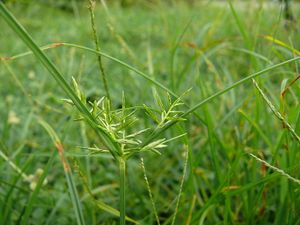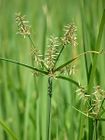Note: This is a project under development. The articles on this wiki are just being initiated and broadly incomplete. You can Help creating new pages.
Difference between revisions of "Cyperus rotundus - Mustaka"
(→Uses) |
(→List of Ayurvedic medicine in which the herb is used) |
||
| Line 47: | Line 47: | ||
==List of Ayurvedic medicine in which the herb is used== | ==List of Ayurvedic medicine in which the herb is used== | ||
| − | * [[ | + | * * [[Bilvādileha]] |
==Where to get the saplings== | ==Where to get the saplings== | ||
Revision as of 10:42, 25 September 2018
Cyperus rotundus is a perennial plant that may reach a height of up to 140 cm. It prefers dry conditions, but will tolerate moist soils, and often grows in wastelands and in crop fields.
Contents
- 1 Uses
- 2 Parts Used
- 3 Chemical Composition
- 4 Common names
- 5 Properties
- 6 Habit
- 7 Identification
- 8 List of Ayurvedic medicine in which the herb is used
- 9 Where to get the saplings
- 10 Mode of Propagation
- 11 How to plant/cultivate
- 12 Commonly seen growing in areas
- 13 Photo Gallery
- 14 References
- 15 External Links
Uses
Leprosy, Thirst, Fever, Curing liver disorders, Blood diseases, Biliousness, Dysentery, Pruritis.
Parts Used
Chemical Composition
Alpha-cyperone (11.0%), myrtenol (7.9%), caryophyllene oxide (5.4%) and beta-pinene (5.3%) were major compounds in the oil of sample A. The main constituents of the oil of sample B were beta-pinene (11.3%), alpha-pinene (10.8%), alpha-cyperone (7.9%), myrtenol (7.1%) and alpha-selinene (6.6%)[1]
Common names
| Language | Common name |
|---|---|
| Kannada | abdahullu, koranari-gadde |
| Hindi | Bara-nagar-motha |
| Malayalam | karimuttan |
| Tamil | korai, korai kilangu |
| Telugu | bhadra-tunga-muste |
| Marathi | NA |
| Gujarathi | NA |
| Punjabi | NA |
| Kashmiri | NA |
| Sanskrit | abhrabheda, ambhodhara |
| English | Common Nut Sedge |
Properties
Reference: Dravya - Substance, Rasa - Taste, Guna - Qualities, Veerya - Potency, Vipaka - Post-digesion effect, Karma - Pharmacological activity, Prabhava - Therepeutics.
Dravya
Rasa
Tikta (Bitter), Kashaya (Astringent), Katu (Pungent)
Guna
Laghu (Light), Ruksha (Dry)
Veerya
Sheeta (cold)
Vipaka
Katu (Pungent
Karma
Kapha, Pitta
Prabhava
Habit
Identification
Leaf
| Kind | Shape | Feature |
|---|---|---|
| Simple | alternate | Leaves sprout in ranks of three from the base of the plant |
Flower
| Type | Size | Color and composition | Stamen | More information |
|---|---|---|---|---|
| Bisexual | 2-4cm long | Yellow | 5-8 | Flowers Season is June - August |
Fruit
| Type | Size | Mass | Appearance | Seeds | More information |
|---|---|---|---|---|---|
| three-angled achene | 7–10 mm | The root system of a young plant initially forms white, fleshy rhizomes | fleshy rhizomes | many | {{{6}}} |
Other features
List of Ayurvedic medicine in which the herb is used
Where to get the saplings
Mode of Propagation
How to plant/cultivate
Prefers a moist sandy loam and a sunny position[3]
Commonly seen growing in areas
Roadsides, sandy fields, cultivated ground, damp places.
Photo Gallery
References
External Links
- Ayurvedic Herbs known to be helpful to treat Leprosy
- Ayurvedic Herbs known to be helpful to treat Thirst
- Ayurvedic Herbs known to be helpful to treat Fever
- Ayurvedic Herbs known to be helpful to treat Curing liver disorders
- Ayurvedic Herbs known to be helpful to treat Blood diseases
- Ayurvedic Herbs known to be helpful to treat Biliousness
- Ayurvedic Herbs known to be helpful to treat Dysentery
- Ayurvedic Herbs known to be helpful to treat Pruritis
- Herbs with Roots used in medicine
- Herbs with Seeds used in medicine
- Herbs with common name in Kannada
- Herbs with common name in Hindi
- Herbs with common name in Malayalam
- Herbs with common name in Tamil
- Herbs with common name in Telugu
- Herbs with common name in Sanskrit
- Herbs with common name in English
- Habit - Perennial plant
- Index of Plants which can be propagated by Seeds
- Herbs that are commonly seen in the region of Roadsides
- Herbs that are commonly seen in the region of sandy fields
- Herbs that are commonly seen in the region of cultivated ground
- Herbs that are commonly seen in the region of damp places
- Herbs







